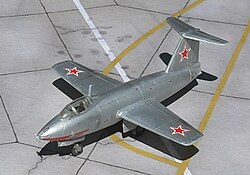Mikoyan-Gurevich I-270
| Mikoyan-Gurevich I-270 | |
|---|---|
 Model of the I-270 |
|
| Type: | Rocket plane |
| Design country: | |
| Manufacturer: | |
| First flight: |
|
| Number of pieces: |
2 prototypes |
The Mikoyan-Gurewitsch I-270 ( Russian Микоян-Гуревич И-270 , NATO code name Type 11 ) was a Soviet missile aircraft . It was created shortly after the end of the Second World War and was inspired by the German Junkers Ju 248 , a complete copy of which fell into the hands of the Red Army when the Junkers factories were conquered in 1945 , but it is an in-house design -270 in contrast to the swept wings of the Ju 248 via conventional trapezoidal wings and a horizontal stabilizer .
history
Development work began after the engine was developed in 1945 at OKB Mikoyan-Gurevich , which broke new technological ground with this type. Two prototypes were created under the project name "Sch" ( Russian Ж , the abbreviation for liquid rocket engine).
The drive was a two-chamber rocket engine designed by Leonid Duschkin and Valentin Gluschko based on German documents with a burn time of 4.24 min at maximum power, with one chamber generating the maximum thrust of 14 kN required for take-off and climbing power and the other the marching thrust of 4 kN. The total burning time at minimum power was 9.3 minutes.
The I-270, which was designed in all-metal construction, received a pressure cabin and an arrow-shaped horizontal stabilizer mounted on the vertical stabilizer. Since the trapezoidal wings of the middle decker were kept very thin with a laminar profile, the landing gear was pulled into the spindle-shaped fuselage.
The flight tests began in 1946 under the test pilot W. N. Juganow . As with its German predecessors, the I-270 achieved remarkable flight performance for the time, but also suffered from the typical shortcoming of its too short range. The further development of this project was therefore discontinued in favor of the MiG-9 with jet propulsion , which was also in the test phase . Both prototypes were destroyed in crash landings during testing.
Technical specifications
| Parameter | Data |
|---|---|
| crew | 1 |
| length | 8.82 m |
| span | 7.75 m |
| height | 3.08 m |
| Wing area | 12.00 m² |
| Wing extension | 5.0 |
| Empty mass | 1,893 kg |
| Takeoff mass | 4,120 kg |
| drive | a liquid rocket engine Duschkin-Gluschko RD-2M-3W with 14.5 kN thrust |
| Top speed | near the ground 1,000 km / h at 15,000 m height 926 km / h |
| Landing speed | 168 km / h |
| Rise time | 1.00 min at 5,000 m height 2.23 min at 10,000 m height 2.90 min at 15,000 m height |
| Summit height | 18,000 m |
| Takeoff route | 895 m |
| Landing route | 493 m |
| Armament | two 23 mm NS-23 cannons (40 shells each) in the fuselage |
literature
- Rudolf Höfling: MiG aircraft since 1939 . Motorbuch, Stuttgart 2011, ISBN 978-3-613-03335-1 .
- Wilfried Bergholz: Russia's great aircraft manufacturer. Jakowlew, Mikojan / Gurewitsch, Suchoj. The complete type book . Aviatic, Oberhaching 2002, ISBN 3-925505-73-3 .
- Karl-Heinz Eyermann : MiG aircraft . Transpress, Berlin 1987, ISBN 3-344-00193-0 .
Web links
Individual evidence
- ^ Jefim Gordon , Bill Sweetman: Soviet X-Planes - Experimental and Prototype Aircraft, 1931-1989 . Motorbooks International, Osceola 1992, ISBN 0-87938-498-0 .
